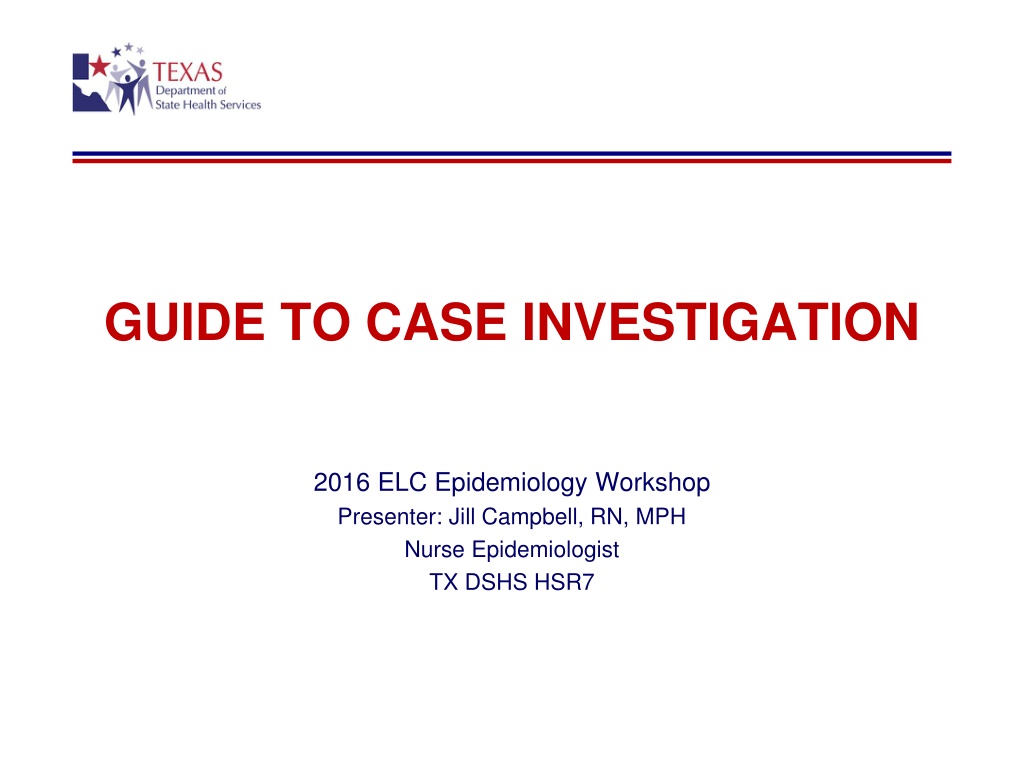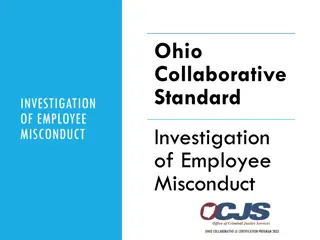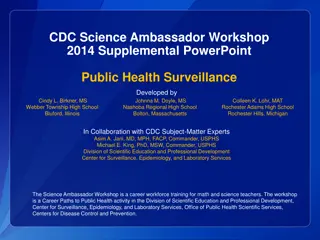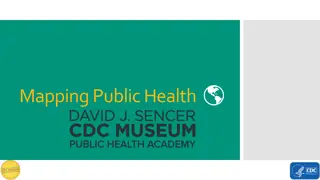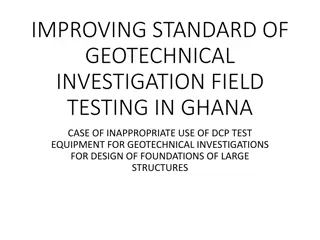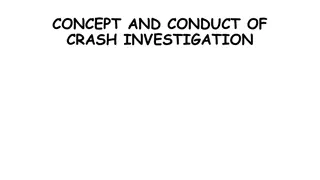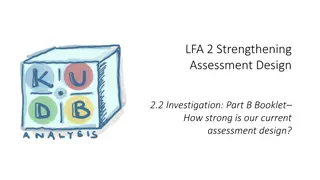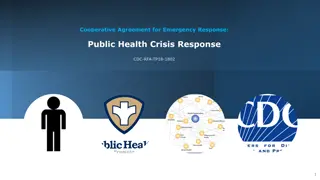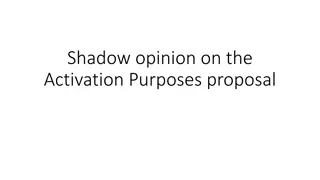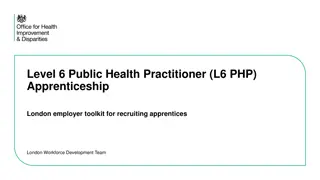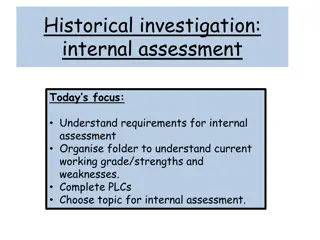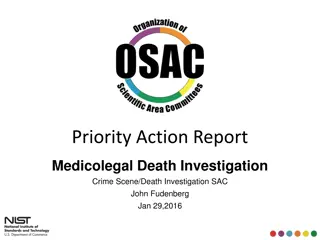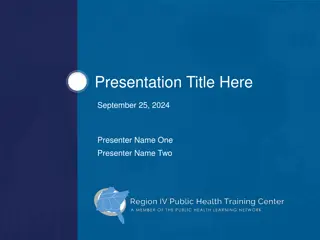Comprehensive Guide to Case Investigation for Public Health Purposes
Explore the importance of developing a case investigation guide in public health, covering its purpose, benefits, and steps to create a template. Learn why consistency and training are crucial, along with tips for effective guide development.
Uploaded on Sep 29, 2024 | 0 Views
Download Presentation

Please find below an Image/Link to download the presentation.
The content on the website is provided AS IS for your information and personal use only. It may not be sold, licensed, or shared on other websites without obtaining consent from the author. Download presentation by click this link. If you encounter any issues during the download, it is possible that the publisher has removed the file from their server.
E N D
Presentation Transcript
GUIDE TO CASE INVESTIGATION 2016 ELC Epidemiology Workshop Presenter: Jill Campbell, RN, MPH Nurse Epidemiologist TX DSHS HSR7
OBJECTIVES Why develop case investigation guide? Case investigation - public health purpose? Provide template for conducting a case investigation.
Case Investigation Guide - Why Training purposes and resource guide Consistency across staff/program Risk management/ Quality Assurance & Improvement Component: Public Health Impact a of Missed Investigation High volume of reports High consequences Accreditation national level Develop your guide to case investigation before an incidence occurs and you are having to put a guide in place due to an investigation error
Case Investigation Purpose Protect population health Position funding can determine aspect/components of investigation Type of agency state, regional, local
Case Investigation Template Agency s Letterhead Standard Operating Guide, Procedure, Policy Subject: Target audience: Supersedes: Responsible Position: Original Date: Revised/Reviewed Date: Submitted By/Title: Manager Approval/Date: Approved by/Title/Date: Approved by (signatures)
Tips for Developing a Guide Assess available staff select best person(s) for the task Determine what the guide is to cover Get something down on paper Communicate clearly Set timelines Don t re-invent the wheel
Case Investigation Template Agency s Letterhead Standard Operating Guide Subject: Case Investigation Target audience: Epidemiology Program Staff Supersedes: N/A Responsible Position: Lead Epidemiologist Original Date: 1/28/2016 Revised/Reviewed Date: N/A Submitted By/Title: Lead Epidemiologist Manager Approval/Date: PHP/EPI Manager Approved by/Title/Date: Regional Director Approved by (signatures)
Lets Get Started Body I. The purpose is to provide a standard program guide for case investigation of the current Texas Reportable Condition. http://www.dshs.state.tx.us/idcu/investigatio n/conditions/ II. Steps: The following steps A. through E. are a guide for a case investigation. Purpose:
II. Step A. Reports 1. Determine if this section of your guide will address management of all incoming reports or if incoming reports management needs to be a separate guide. 2. Report is assign to staff. Review and verify the disease report received with a disease you are responsible to investigate. a. Yes proceed with investigation b. No route the report to assigned investigator or file appropriately.
II. Step B. Investigation 1. Review the report information checking the disease is a Texas Notifiable Condition and lab submitted supports diagnosis and case definition of this disease/infection. 2. Review disease specific information, DSHS The Emerging and Acute Infectious Disease Guidelines and or CDC website. The state disease specific investigation and surveillance forms are available at: http://www.dshs.state.tx.us/idcu/investigation/ 3. If a specific guide or form is not available; the investigator will review relevant material, including DSHS and CDC guidance and proceed to consult with program lead epidemiologist, supervisor, etc. 4. The investigator will call provider who ordered the test if appropriate for chart review as indicated and to determine if the case knows test results prior to investigator contacting the case. 5. Inform program lead(s) or manager of all immediate and bioterrorism conditions investigation when investigation is started.
B. Investigation - continued 6. Immediate, bioterrorism and one working day reportable conditions will be initiated same day received. Weekly reportable condition will be initiated within XX working days of receipt unless associated with on going outbreak. 7. Initial contact will be by phone. If necessary to leave a message use the following: Hello my name is your name here I am with the Texas State Health Department, I have confidential health information to discuss with you (or if calling a minor the parent or guardian of) person calling name here . I can be reached at my office at (555) 555-5555 between 8 am and 5 pm Monday through Friday. Thank you. Reminder: DO NOT leave personal health information on message
B. Investigation - continued 8. Now that you have initiated the investigation your program will need to determine the following (keep in mind your population s health): a) Time period to wait for return call, immediate vs. weekly reports b) Number of contact attempts (3 seem to be a common thread) c) Time of day contact is made (recommend varying). Calling after hours? d) Is your program going to use letters and or home visits? e) Time period for over all investigation to be completed 30 days? f) When is report closed as LOST TO FOLLOW UP? 9. Keep in mind reason to investigate is to: a. Search for undiagnosed cases/epi-link cases b. Education the person about the disease and prevent further spread c. Determine what public health intervention is necessary d. Assure contacts are identified and have a source of care
B. Investigation - continued 10. Conducting the investigation interview: a. Be familiar with the investigation form. Ask questions in order unless asking a question could potentially end the interview without getting the critical public health information needed to stop or prevent disease transmission. (exposure, transmission) b. Be respectful and honest c. Give the individual the opportunity to ask questions. d. Close investigation interview thanking the individual for their time and repeat your name and contact information. Hint: DSHS provides a good training on conducting a foodborne interview. This technique can be applied in all investigations http://www.foodborneepitexas.org/
II. Step C. Documentation 1. Label the investigation in accordance with your program guideline. Example: case name, date of birth, NBS ID number? 2. Case identifying information is recorded on all pages that contain case investigation information. 3. Investigation Forms: a. Electronic: complete the form via computer and print to attach to report along with any pertinent information gathered during the investigation. b. Paper: document in ink, error corrections are made with single line drawn though and initiated. Attach investigation form to the report along with any pertinent information gathered during the investigation. c. Sign forms as indicated
C. Documentation cont. 4. Investigation Documentation Order: a. Disease specific case surveillance and investigation form b. Confirmed/pertinent lab reports c. Case investigation pertinent medical information d. Case investigation progress/additional notes e. Miscellaneous documentation pertinent to the case investigation, such as email correspondence, newspaper articles
II. Step D. NBS Data Entry 1. The assigned investigator is responsible for case investigation data entry in NEDSS Based System (NBS). Creation of a case investigation maybe at the beginning of assignment or the end once the investigation is completed. Your program can make this decision. The data entry will be accordance with the current DSHS document titles Texas NEDSS Base System (NBS) DATA ENTRY GUIDE Emerging and Acute Infectious Disease Branch Zoonosis Control Branch . 2. 3. The Texas NEDSS Base System (NBS) DATA ENTRY GUIDE document can be located in the Texas NEDSS login page by clicking on the Documents link ; UserResources: NBSDataEntryGuideSep2015.pdf
II. Step E. Closing Investigation 1. All investigation are closed in NBS Within XX days of investigation being opened By the assigned investigator. An investigation has been officially closed when: The investigation has been ruled out closed as Not-A-Case A NBS notification has been sent for confirmed or probable cases The completed investigation form has been faxed to DSHS regional or central office The investigation is entered into program database, if choose to have one A completed and closed investigation is appropriately filed and record retention followed. 2. 3. NOTE:In the event an investigator is not going to make a XX day deadline it is the investigator responsibility to notify the program epi lead in timely manner
IN CLOSING - OBJECTIVES Why develop case investigation guide? Training purposes and resource guide Consistency across staff/program Risk management/ Quality Assurance & Improvement Component: PH Impact of missed investigation High volume of reports High consequences Accreditation national level Case investigation - public health purpose: Protect population health Position funding can determine aspect/components of investigation Type of agency state, regional, local Provide template for conducting a case investigation
Questions My Contact Information: Jill Campbell, RN, MPH DSHS HSR7 Nurse Epidemiologist 2408 south 37th St., Temple TX76504 254 771-6729 desk Jill.Campbell@dshs.state.tx.us
